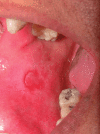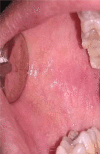Comparing the Effectiveness of Low-Level Laser Therapy and Topical Steroid Therapy Combination Regimen With Routine Topical Steroid Therapy in the Management of Oral Lichen Planus Symptomatic Patients
- PMID: 37750131
- PMCID: PMC10518139
- DOI: 10.7759/cureus.44100
Comparing the Effectiveness of Low-Level Laser Therapy and Topical Steroid Therapy Combination Regimen With Routine Topical Steroid Therapy in the Management of Oral Lichen Planus Symptomatic Patients
Abstract
Background: For symptomatic oral lichen planus (OLP), a wide range of therapeutic approaches have been suggested. To minimize discomfort and symptoms among individuals with symptomatic OLP, extensive therapy is frequently needed. Therefore, finding a new therapeutic approach that may effectively manage OLP's symptoms and signs while having few adverse effects continues to be a difficult task. Recently, low-level laser therapy (LLLT) has become a popular alternative therapy option for OLP with no serious side effects.
Aim: The present research was designed to compare the effectiveness of a combination regimen of LLLT in addition to topical steroids with routine topical steroid therapy separately in order to manage patients with bothersome OLP with an extended period of follow-up.
Materials and methods: In our trial, 60 patients were chosen and given sequential numbers as they signed up to take part. The participants were divided randomly into two categories: category A (LLLT plus topical steroids) and category B (only topical steroids). The data were entered into the aforementioned prepared case template after receiving informed consent. The aforementioned prepared case template included the following criteria for evaluating the result of the treatment: pain, recurrence, burning sensation, clinical remission, and size of the lesion. Applying the visual analog scale (VAS), pain, as well as burning sensations, were assessed in both categories. With the aid of the Electronic Digital Vernier Caliper (Mitutoyo, China), these individuals were assessed for the dimension of the lesion.
Results: The pain score on day 21 of intervention in category A was 2.5, while it was 4.63 in category B. The difference in findings was significant statistically at day 21 (p = 0.0032). The pain score on day 28 of intervention in category A was 1.3, while it was 3.0 in category B. The difference in findings was significant statistically at day 28 (p = 0.003). The pain score was greater in the control category as compared to the intervention category. The burning sensation score on day 21 of intervention in category A was 2.5, while it was 4.5 in category B. The difference in findings was significant statistically (p = 0.0024). The burning sensation score at the follow-up phase on day 45 of intervention in category A was 1.1, while it was 3.4 in category B. The difference in findings was significant statistically (p = 0.002).
Conclusion: Newer therapeutic techniques are becoming accessible to oral specialists for controlling oral mucosal disorders as a result of evolving dental trends. The gold standard for treating people with symptomatic OLP continues to be topical corticosteroids. The therapeutic advantages of topical corticosteroids, however, are considerably outweighed by their complementary effect when paired with newer treatment methods like LLLT.
Keywords: burning sensation; lllt; oral lichen planus; pain; topical steroids.
Copyright © 2023, Panchal et al.
Conflict of interest statement
The authors have declared that no competing interests exist.
Figures
References
-
- Increased frequency of HLA-DR6 allele in Italian patients with hepatitis C virus-associated oral lichen planus. Carrozzo M, Francia Di Celle P, Gandolfo S, et al. Br J Dermatol. 2001;144:803–808. - PubMed
-
- Lack of association between hepatotropic transfusion transmitted virus infection and oral lichen planus in British and Italian populations. Bez C, Hallett R, Carrozzo M, et al. Br J Dermatol. 2001;145:990–993. - PubMed
-
- Oral lichenplanus: etiology, pathogenesis, diagnosis, and management. Gangeshetty N, Kumar BP. World J Stomatol. 2015;4:12–21.
-
- Oral lichen planus: a review of etiopathogenesis, clinical, histological and treatment aspects. Chitturi RT, Devy AS, Nirmal RM, Sunil PM. https://www.omicsonline.org/open-access/oral-lichen-planus-a-review-of-e... JBR J Interdiscip Med Dent Sci. 2014;2:2–5.
LinkOut - more resources
Full Text Sources


